MAIN PAGE 2
Depicting Dehumanization in
Beloved and Maus
How to read this page
Outline page 2
Overview over Project
DEHUMANIZATION
Written by Alexander Kimel - Holocaust Survivor
Skip this quote
In civilized societies a condemned man is provided with some comfort and
the process of execution is geared to inflict the minimum amount of emotional
and physical pain; the State provides the services of clergyman to ease
the anxieties and sufferings. The Germans did just the opposite, the system
was geared to provide the maximum pain, all religious observances were
punished with death, praying was not allowed. In order to make the killing
and oppression psychologically easy for the oppressors, dehumanization
of the victims had to take place. The process was quite simple; the victims
forced to behave like beasts proven that the are subhuman, victims forced
to live without sanitary facilities prove that they enjoy filth, etc. In
the concentration camps, the inmates were so "broken-in" that they were
almost oblivious to their lot....
The Germans established a bureaucracy that dealt with people
like we are dealing with commodities not even cattle. For example coal
is mined, stored, transported and burned in a casual manner, when it comes
to transport cattle man is more careful; cattle requires the supply of
fodder, water and proper facilities. The SS dealt with their victims like
with commodities. People were collected, stored, transported to Gas Chambers
for processing without any provision of food, water or sanitary facilities.
On the opposite the lack of food especially water was used cruelly for
facilitating the destruction; hungry, thirsty, emaciated people do not
resist. For example a transport of Jews from Salonik was travelling for
three weeks to Auschwitz, without water, food , upon arrival to Auschwitz
they were herded to the Gas Chambers, and promised a glass of tea upon
disinfection. People dying from thirst were fighting to get into the gas
chambers. Why all this cruelty? Psychologically it is explained that powerless,
inferior victims are causing a high level of anxiety and frustration in
their oppressors, who act out the rage on the same victims. So it is necessary
to dehumanize the victims and make their destruction easier for the oppressors.
|
|
Three ways to depict de-humanization
There are at three different ways man de-humanizes another man, says
Richard Rorty in one of his essays: to
treat a man like an animal; to treat a man like a woman; and to treat a
man like a child. There are also three ways in which human beings de-humanize
other human beings in Beloved
and Maus. They differ slightly
from Rorty's account:
Of course, saying that human beings were treated as animals, children or
items is an attempt to link the concept of animals, children or things
to the unspeakable reality. We can get quite attached to animals, children
or even things. Animals, children and things are anchor-terms
with which we will deal on other pages.
Aside from the inhumane conditions in which the characters had to live
- the camp life where relatives would help each other only in exchange
for material goods, f. ex. -, we will only look into the depiction
of de-humanization in Beloved and
Maus. In other words: not the inhumane world that is the setting of
the novels shall be discussed, but in which terms human beings are being
depicted.
Human Beings as Animals
Both Maus and Beloved present human beings as if they were animals.
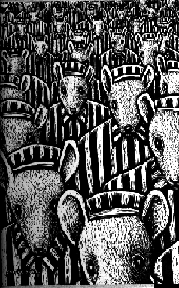 |
In Maus, it is most obvious in the characters: the Jews
are mice, the Nazis cats, the Frensh are frogs and the Polish are pigs.
The whole book is called Maus, which is German for mouse. A quotation by
Hitler at the beginning of Maus I (p.4) makes clear the aim of the book
to show the de-humanization: "The Jews are undoubtely a race, but they
are not human." The same issue is taken up in the beginning of Maus II,
(front pages) where a newspaper article from the mid-thirties in Germany
is quoted: "Mickey Mouse is the most miserable ideal ever revealed... Healthy
emotions tell every independant young man and every honorable youth that
the dirty and filth-covered vermin, the greatest bacteria carrier in the
animal kingdom, cannot be the ideal type of animal... Away with the Jewish
brutalization of the people! Down with Mickey Mouse! Wear the Swastika
Cross!" Nazi propaganda is known to have depicted Jews as rats, too. |
| So Spiegelman's depiction of people as animals merely reflects the
de-humanizing spirit of the times. In these conditions of war, all people
became animals. It is interesting to note that into
the second book, after Spiegelman has already dealt in depth with his father's
history (p. 41-47), he depicts himself in the act of drawing, and
overcoming his own anxieties about his project as a human being, wearing
a mouse-mask. This suggests that when dealing with his dad and the
memories of the time, Spiegelman and all other people assume the mindset
of that depressing time again. Likewise, the TV-reporters who invade his
privacy, and hunt him down with their questions, are presented with cat-masks.
The memory pervades reality, reaches into Spiegelman's present life, forms
a veil that lies upon mind.
There are other times when human-beings are being drawn as human beings.
One example is on pages 100 following, when Spiegelman presents an old
comic about the death of his mother. He reads it as a mouse, reads
it as a recollection of another time when his mother was his still his
human being mother and not Anja the mouse. A second example is when three
pages before the end of the second book, Vladek's real life photo springs
out of a corner. It is shown upon the occasion that Anja finds out
her husband has survived the camps - survuived the de-humanization!
to
the right: pictures from Schindler's list, Maus |
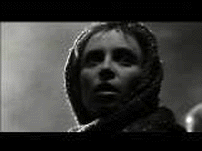
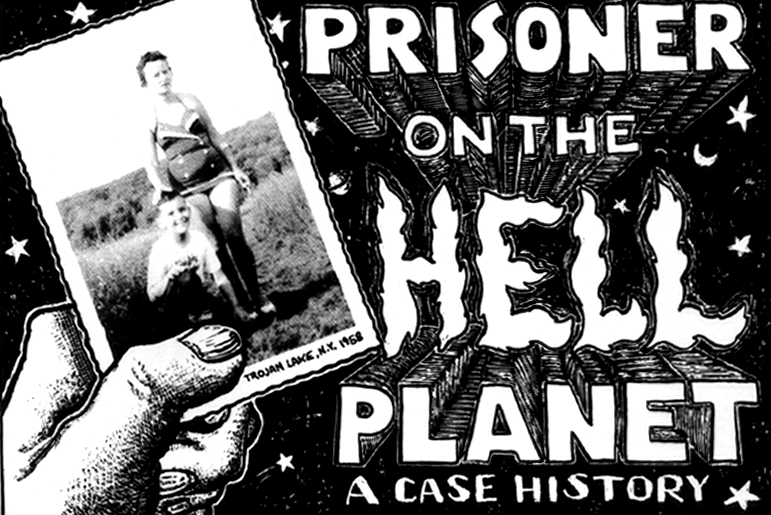

|
But the case for human beings being depricted as animals in Maus goes
way beyond the mere drawing of figures. Repeatedly is made reference to
human beings being treated, or behaving like animals: when they live together
with rats (148, I), or in the garbage dump (153, I), when they have to
chew on woods (123, I), when put in "such a train for horses, for cows"
where they "lay on top of each other, like matches,
like herrings" (85, II), or when they are shot like dogs (82, II). Spiegelman
also repeatedly plays with the image of bars, suggesting the mice are trapped,
so on page 74 (I).
 |
In Beloved, too, human beings are depicted as animals. First, Sethe
overhears Schoolteacher tell his pupils: "I told you to put her human characteristics
on the left; her animal ones on the right." (p. 193). Schoolteacher thinks
of her as animal at other places (f. ex., when thinking of her "breeding
years", p. 149), but even worse, he and his pupils treat her like a cow
when the white pupils "take her milk" in the barn (p.70). Ultimately, they
also rape her there. Had the black men at Sweet home already been so desperate
that they turned to calfs for sex, then the white man's taking Sethe's
milk and raping her at the same time is an ulitmate act of de-humanization.
Sethe is stripped of all human dignity in these moments.
to the left: the branding
of a slave |
Human beings as children
| Blacks were often treated as children. "Boy"
was how many old Blacks were called up until the 1960'ies. Their treatment
as children is not so obvious in Beloved. It appears in subliminal form
when the "men of Sweet Home" take pride in being taken serious as men:
"He (Paul D., C.G.) grew up thinking that,
of all the Blacks in Kentucky, only the five of them were men. Allowed,
encouraged to correct Garner, even defy him. (...) Was that it? Is that
where the manhood lay? In the naming done by a whiteman who was supposed
to know? Who gave them the privilege not of working but of deciding how
to? No. In their relationship with Garner was true metal: they were believed
and trusted, but most of all they were listened to. He thought what they
said had merit, and what they felt was serious. Deferring to his slaves'
opinions did not deprive him of authority of power. It was schoolteacher
who taught him otherwise." (p.125)
Morrison goes on to describe the men of Sweet-home as 'watchdogs without
teeth, steer bull without horns' once the men are off the ground of Sweet
home. So she is making her point with animals here.
However, reading the above paragraph will do enough to invoke the image
of the "black boy" in the informed reader. - Once schoolteacher comes,
their manhood is taken from these men. They are no longer being taken serious
- they are stripped of their humanity. |


Slave-hut,
above; working slave,
below
|
| The case for the depiction of human beings as children is not so strong
in Maus, either. Occasionally, the behaviour of characters resembles
that of children, so on page 122 (Maus I) when Anja cries hysterically
for her family: "Grandma and grandpa! Poppa! Momma!..." How children themselves
is given no chance for survival, and how they are being crushed to death
like little kitten smashed to the wall is depicted on p. 108 (I).
Most poignant is the interrelation between de-humanization and the treatment
of human beings as children on pages 42 through 47 in Maus II. It
has been suggested above that Spiegelman feels himself hunted down
by the media. They shamelessly offer to exploit his personal his-story,
and Spiegelman, the author, shrinks from a grown man to a child. As such
he seeks then help from a psychiatrist. Again, it seems that Spiegelman
assumes the mindset of a child when it becomes too hard for him to deal
with these memories, and the past.
to the right: scenes from Schindler's list
|
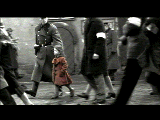
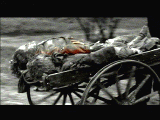
|
Human beings as items
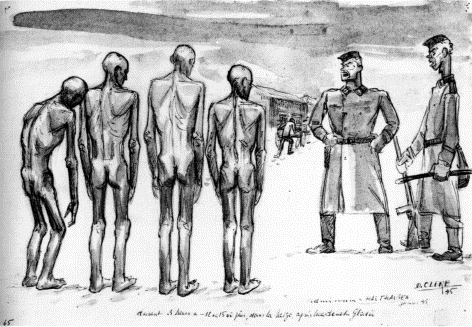
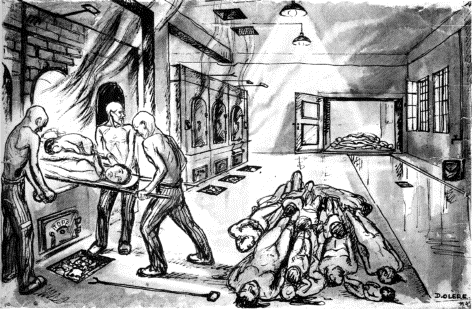
|
How human beings became material, is one the saddest and well-known
stories of the Holocaust: Human beings became lamp-shades, soap. They were
put in the ovens the way a baker shoves bread into his oven. Upon arrival,
they were tattoed with a number. Much of this is reflected in Maus. On
page 26, II, Vladek shows his tattoed number 175113. On the next page,
the escape from Auschwitz seems only possible through the smoke-stacks
("Abraham I didn't see again... I think he came out the chimney"). About
the crematoriums, Vladek later says: "This was a factory to make - one,
two, three - ashes and smoke from all what came here." (70, II).
In the 'selektions', Jews are scrutinized for their working-ability, and
sorted out as if they were bad screws (58, II).
to
the left: Human beings - work material |
| Blacks were work-material no better than the Jews. Sethe, Baby Suggs,
Paul D: they were sold. They were property. Sethe survives the killing
of Beloved because she counts as property, and not a human being. Halle
buys his mother free. Paul D. "learns his worth. He has always known, or
believed he did, his value - as a hand, a laborer who could make profit
on a farm - but now he discovers his worth, which is to say he learns his
price. The dollar value of his weight, his strength, his heart, his brain,
his penis, and his future." (p. 227). Sixo, the man who has the strongest
sense of his own individuality, is burned on the stake. Slaves are property
that can be moved or sold or even abandoned as the master likes it... human
dignity is non-existent for slaves.
to the right: slave-market |
 |
Human beings as animals, children, items: de-humanization knows different
forms. Literature often takes great care in making the point of such a
depiction. It makes the account clearer, and speaks between the lines of
de-humanization. As has been noted before, de-humanization can also be
seen in the mere conditions of the setting; an account of the Holocaust
always bears implicitly the idea of destroying individuality, destroying
the humane order of man, regardless
in which form the narrator choses to relate the conditions. But to describe
the overall conditions of slavery or the Holocaust was not our aim here.
The question was how the conditions could be conveyed, how de-humanization
was witnessed.
All of the forms in which
de-humanization is depicted here are also forms of anchor-terms.
To children, to animals, even to things we usually get easy attached to.
It is important to remember that when trying to make sense of the suffering
and pain of de-humanization, they retreat to anchor-terms that help them
make sense.
A gallery of de-humanization
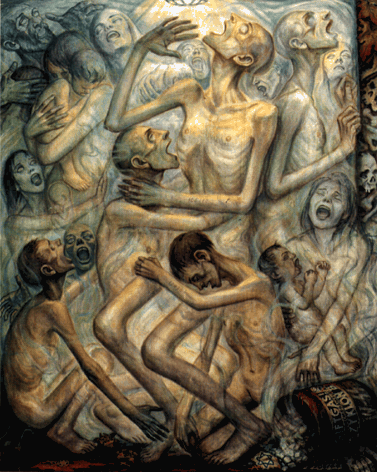
* Five novels as tools of
humanization * - * Depicting de-humanization
* - * Overcoming de-humanization *
Overview Over Project:
Themes and Links












